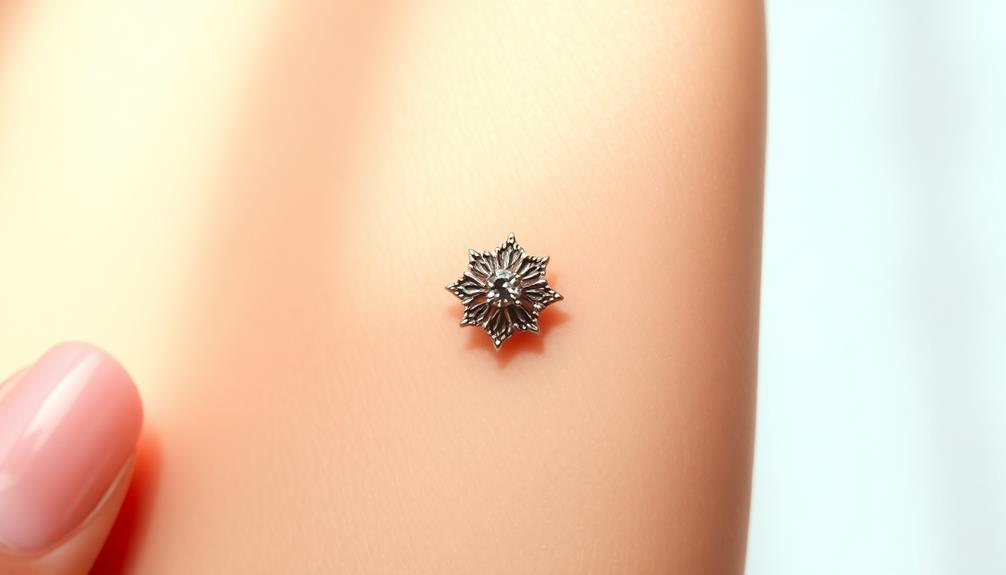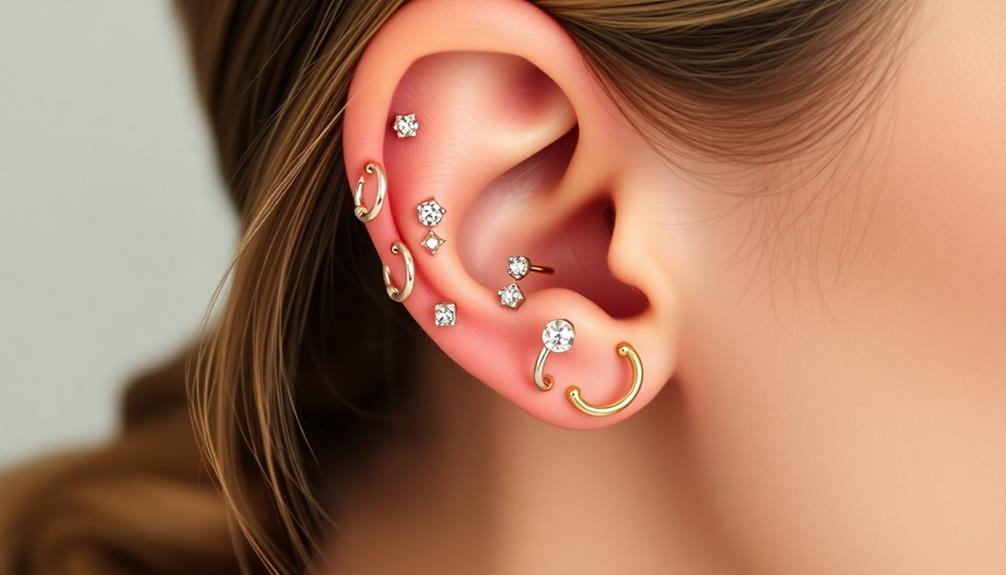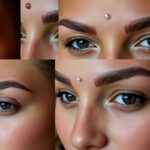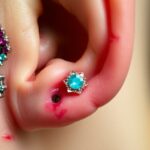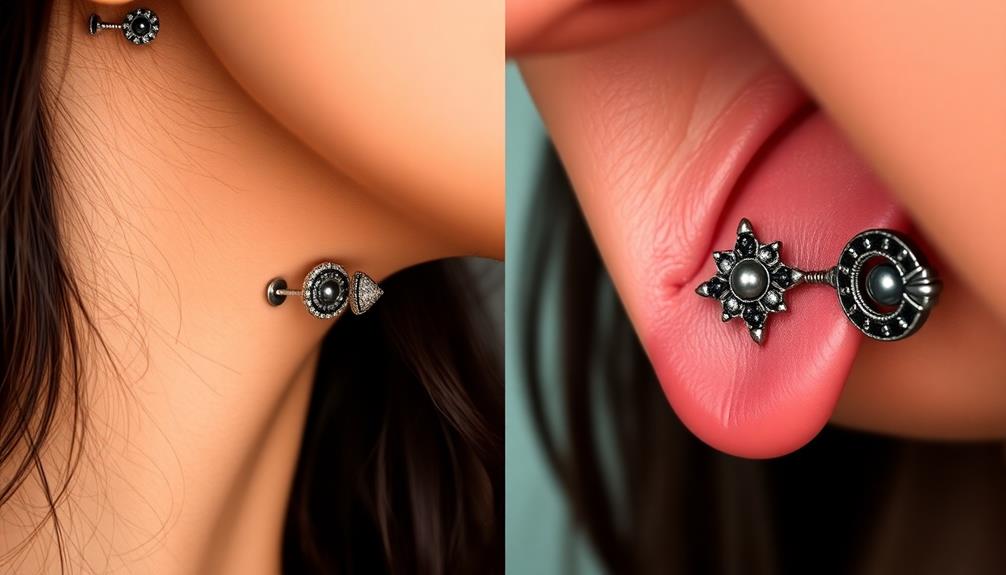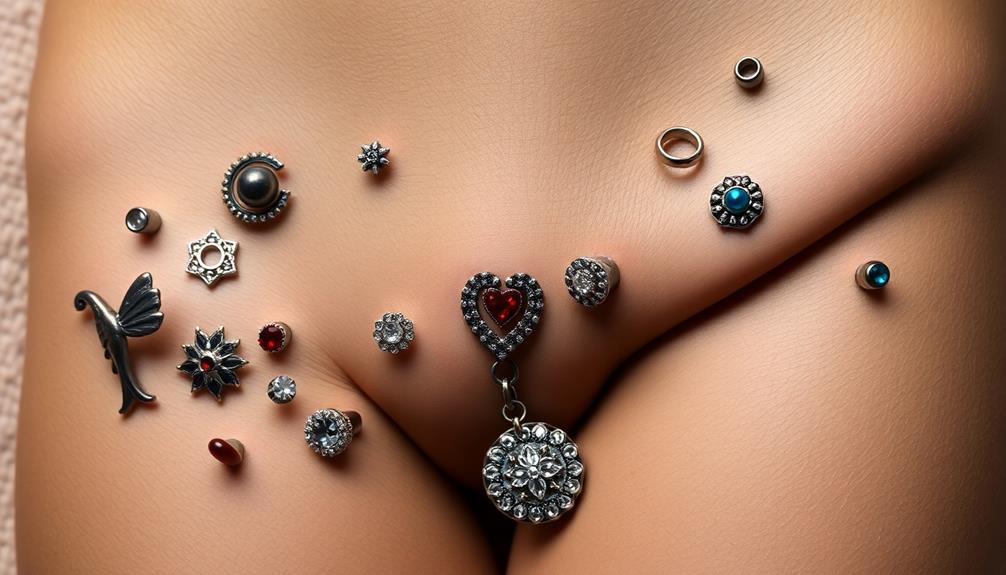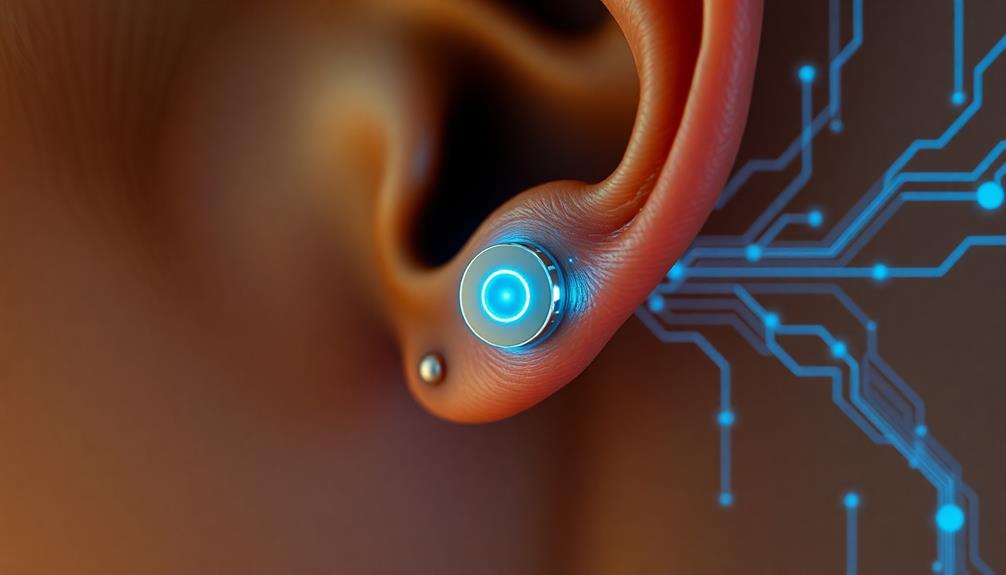Surface piercings can give you a unique aesthetic, but they come with notable risks. These piercings often face high rejection rates, estimated between 70-80%, which can lead to complications like irritation or infection. Healing takes time too, typically ranging from 1 to 5 years. Choosing the right jewelry, such as biocompatible materials and proper length, is essential for success. Proper aftercare, including regular cleaning and monitoring for issues, is crucial. Balancing the aesthetic rewards against these risks is key to your decision. There's more to reflect upon if you're ready to explore what that might entail.
Key Takeaways
- Surface piercings have a high rejection rate of 70-80%, making them riskier than traditional piercings.
- Healing times for surface piercings can vary widely, ranging from 1 to 5 years.
- Proper jewelry selection, such as curved barbells or surface bars, is crucial for comfort and healing.
- Regular aftercare, including saline cleaning and monitoring for irritation, is essential to prevent complications.
- Surface piercings can provide unique aesthetic enhancements, but balancing risks with rewards is important for informed decisions.
Definition of Surface Piercings
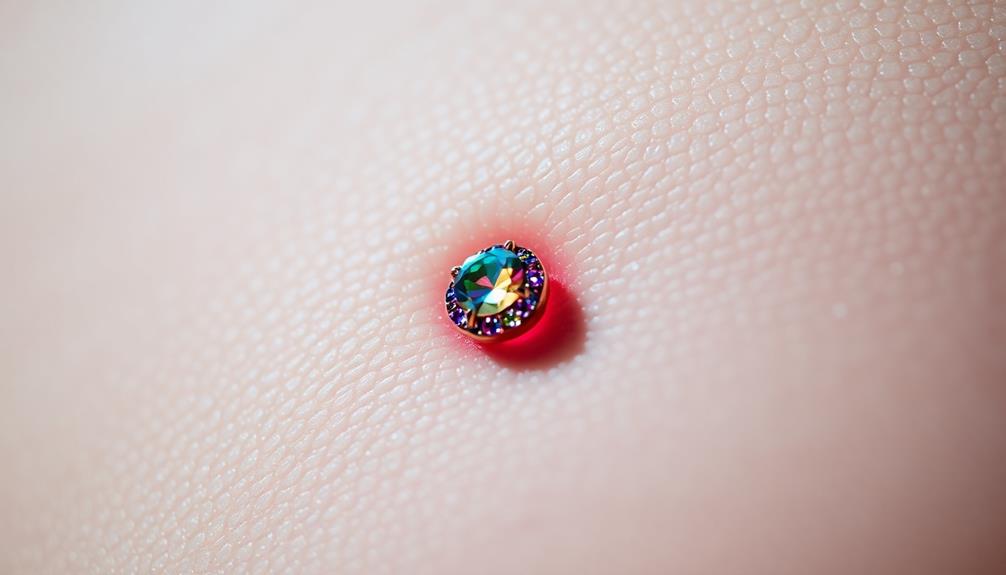
Surface piercings, often referred to as skin-divers, stand out due to their unique design that makes the jewelry look like it's floating just beneath the skin.
Unlike traditional body piercing methods, surface piercings enter and exit on the same side of the skin, which is why they require specialized curved barbell jewelry for proper placement. This design can create an eye-catching effect, but it also comes with its challenges.
One major concern is the healing time, which can range dramatically from 1 to 5 years. During this period, complications are common due to the shallow placement of the jewelry. Because of this, there's a significant chance of rejection over time, meaning the body might push the jewelry out.
If you're at risk, considering alternatives like dermal implants might be wise.
Additionally, it's crucial to recognize that if rejection occurs, surface piercings can leave noticeable scars. These scars often resemble lines where the jewelry once sat, serving as a reminder of the piercing.
Understanding these aspects helps you make informed decisions about surface piercings and their potential risks.
Types of Surface Piercings
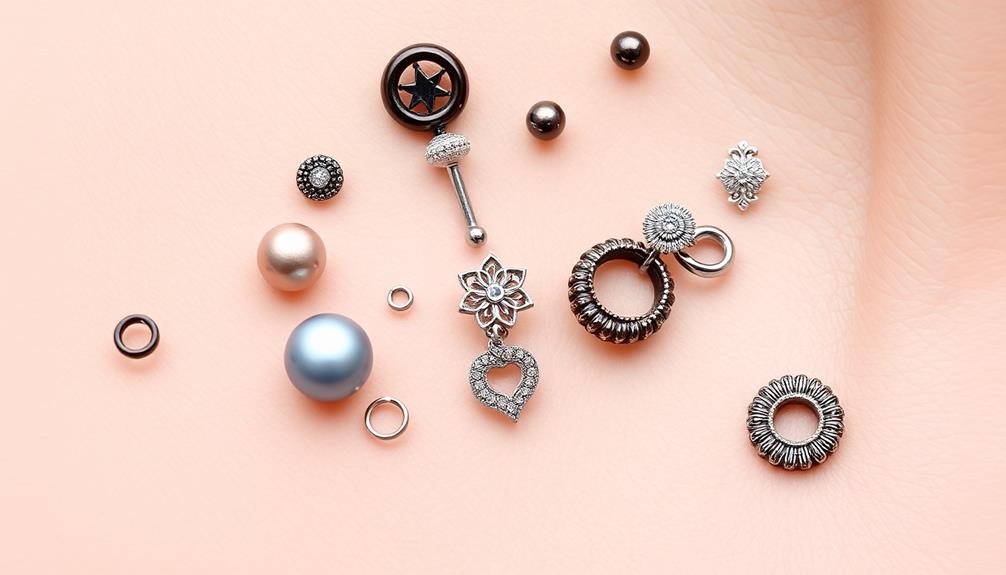
When considering surface piercings, you'll find several common types to choose from, like anti-eyebrow and belly button piercings.
Each type typically uses either surface bars or surface anchors, which can affect how the jewelry looks and feels on your skin.
Understanding these options is essential for making a choice that suits your style and comfort.
Common Surface Piercing Types
Exploring the world of surface piercings reveals a variety of popular types that can enhance your style. These piercings create the illusion of floating jewelry beneath the skin, but it's important to know that they can be prone to migration and rejection over time. Here's a quick look at some common surface piercing types:
| Piercing Type | Location | Unique Features |
|---|---|---|
| Anti-Eyebrow | Just above the eyebrow | Offers a striking facial aesthetic |
| Surface Tragus Piercing | On the tragus of the ear | Provides a unique ear embellishment |
| Belly Button | Lower abdomen | Popular for body art and style |
| Chest | Center of the chest | Creates a bold statement piece |
| Corset Piercing | Along the spine | Mimics a laced corset look |
Among these, surface anchors stand out as they have a base under the skin, allowing for a different aesthetic. Remember, understanding your anatomy is vital for a successful surface piercing, especially in areas with defined features.
Jewelry Options Available
For those considering surface piercings, choosing the right jewelry is essential to both aesthetics and healing.
You'll typically encounter two main options: surface bars and dermal anchors. Surface bars are designed to rest flush against the skin, while dermal anchors feature an anchor that sits beneath the skin's surface, providing a different look and feel.
When selecting jewelry, keep these points in mind:
- Jewelry Gauge Sizes: Surface piercings usually range from 16 to 18 gauge. This size is important for proper healing and comfort.
- Material Matters: Opt for biocompatible materials like titanium, surgical steel, solid gold, or niobium to minimize irritation and promote healing.
- Optimal Design: Curved barbells are often recommended since they reduce movement and the risk of rejection, ensuring your piercing remains secure and looks great.
Anatomy and Healing Considerations

Your anatomy plays an essential role in the success of surface piercings, as certain features can provide better support for the jewelry.
Healing times can vary widely, often taking 1-5 years, and complications like irritation may arise, especially in high-movement areas.
Understanding these factors is important to manage expectations and minimize risks effectively.
Anatomy's Role in Success
The success of surface piercings hinges on the anatomy of the area being pierced, as certain features can provide vital support for the jewelry. When contemplating a surface piercing, you must evaluate the area's anatomical characteristics.
Some spots, like navels and eyebrows, may not be ideal due to their tissue type and movement, which can lead to complications and increase the risk of rejection.
Here are some key factors to take into account:
- Defined tissue structures: Areas with more stable anatomy, like helix piercings, offer better support than those with softer tissues.
- Movement: High movement areas are more prone to rejection, affecting both the success of the piercing and the healing process.
- Individual differences: Your unique anatomy can influence healing experiences, making communication with your piercer important for a successful outcome.
Ultimately, understanding the anatomy involved can enhance your chances of a successful surface piercing and a smoother healing journey.
Healing Duration Variability
Understanding how anatomy affects healing can shed light on the variability in healing durations for surface piercings. Healing time can range dramatically from 1 to 5 years, heavily influenced by your individual anatomy and the specific location of your piercing.
For instance, areas with defined ridges, like the helix, often provide more stability, promoting better healing. Conversely, flatter and more mobile areas, such as the navel or eyebrows, are more susceptible to irritation and longer healing times.
Your tissue characteristics are vital; ideal candidates for surface piercings should have suitable anatomy to minimize risks such as migration and rejection. Unfortunately, surface piercings have a rejection rate estimated between 70-80%, considerably higher than traditional piercings, largely due to movement and tissue type.
Individual variations in anatomy mean that each person's healing experience can differ vastly. This makes it essential for you and your piercer to engage in thorough discussions to set realistic expectations about your healing time and potential risks.
Understanding these factors will help you navigate your surface piercing journey more effectively.
Common Complications and Risks
When it comes to surface piercings, complications and risks can arise that are closely tied to your anatomy and the healing process. Unlike navel piercings, surface piercings have a much higher likelihood of migration and rejection, estimated at 70-80%. Factors such as your body's unique structure greatly influence the success of the piercing.
Areas with distinct ridges usually offer better security, while flat or uneven areas pose more challenges.
You should also be aware of the following complications:
- Rejection or migration: Your body may push the jewelry out, especially if the piercing is too shallow.
- Infection: Poor hygiene or improper aftercare can lead to infections that complicate healing.
- Trauma: Movement or snagging the piercing can exacerbate the risk of complications.
Healing can take anywhere from 1 to 5 years, and rejection can occur at any time during this period.
To minimize complications, proper aftercare is essential. Misunderstanding the needs of surface piercings can lead to increased risks and delayed healing, so stay informed and attentive throughout the process.
Risks of Migration and Rejection

Facing the possibility of migration and rejection is a critical concern for anyone considering surface piercings. These piercings have a migration and rejection rate estimated at 70-80%, considerably higher than traditional body piercings. This high rate stems from the body's natural response to foreign objects, as surface piercings are placed more shallowly, making them more susceptible to being pushed out over time.
Movement, snagging, and trauma to the area can further exacerbate the risk of migration and rejection. If you notice signs of rejection, such as irritation, visible jewelry, or enlarged holes, it's important to act quickly. Removing the jewelry can help prevent additional scarring that may resemble lines on your skin.
Good piercers often assess your anatomy and skin characteristics through pinch tests before piercing to gauge the likelihood of rejection.
Understanding these risks helps you make informed decisions about surface piercings. While they can enhance your look, be prepared for the possibility that your body may not accept them, leading to migration or rejection.
Jewelry Options for Surface Piercings
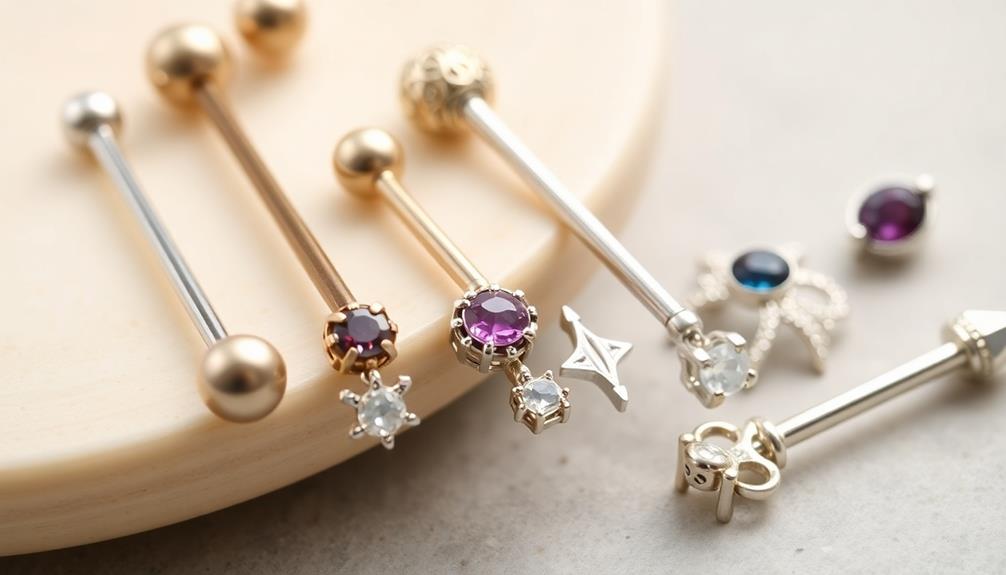
After considering the risks of migration and rejection, it's important to think about the jewelry options available for surface piercings. The right choice can greatly impact your healing process and overall experience. You typically have two primary options: surface bars and surface anchors.
- Surface Bars: These are designed to sit flush against the skin, making them ideal for low-movement areas. They minimize snagging and irritation.
- Surface Anchors: Featuring a base that resides beneath the skin, these anchors can provide a unique aesthetic while offering stability.
- Material Choices: Opt for hypoallergenic materials like titanium, surgical steel, solid gold, or niobium to guarantee durability and reduce the risk of allergic reactions.
When selecting your jewelry, consider gauge sizes of 16 or 18, with lengths between 6-8mm for the best fit.
Aftercare for Surface Piercings
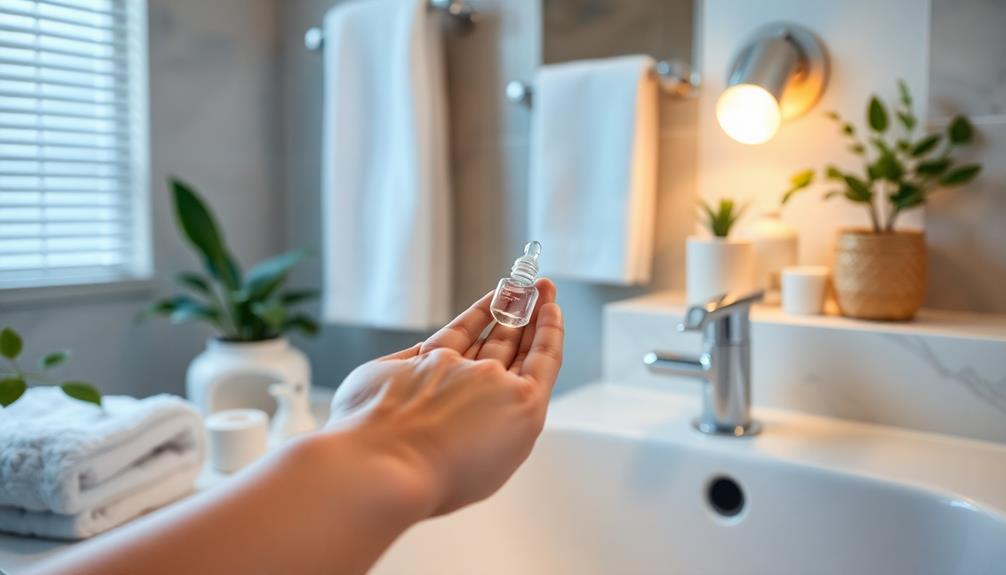
Proper aftercare is essential for ensuring the health and longevity of your surface piercing. Start cleaning your piercing on the day of the procedure using sterile saline, as it's safer than homemade solutions. Clean the piercing twice daily with saline or a mild, fragrance-free soap solution to prevent infection and promote healing.
Here's a simple aftercare routine:
| Step | Action | Frequency |
|---|---|---|
| Clean | Use sterile saline on the piercing site | Twice daily |
| Monitor | Check for signs of irritation or rejection | Daily |
| Avoid | Touching the piercing unnecessarily | Always |
| Apply | Makeup around the piercing | Never |
| Consult | Your piercer for guidance if issues arise | As needed |
Avoid using antiseptics for daily cleaning; they should only be used if signs of infection appear, like redness or discharge. Limiting touching the area helps reduce the risk of contamination and irritation. By following these aftercare tips, you'll enhance your healing process and maintain a healthy surface piercing.
Surface Tragus Piercing Insights
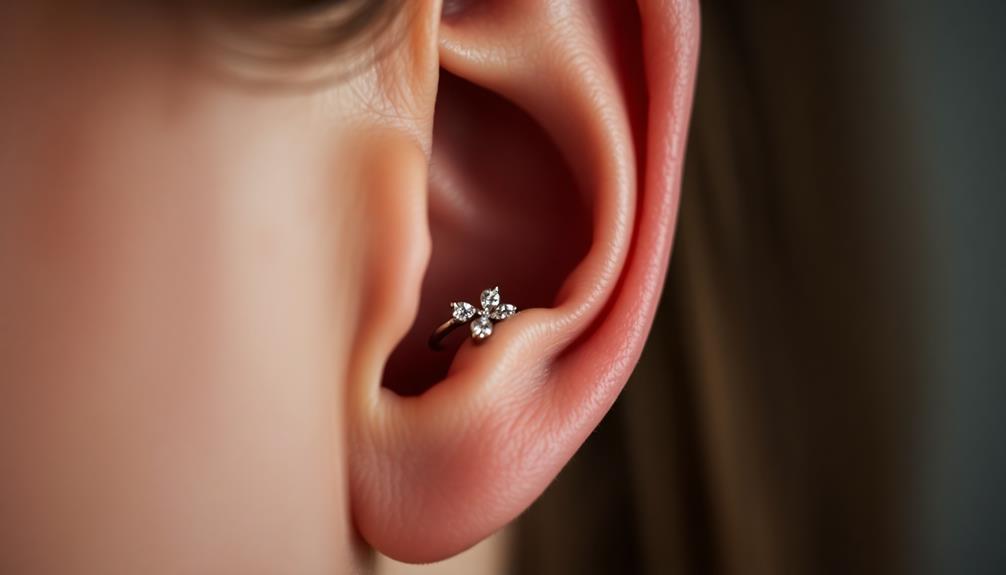
Surface tragus piercings offer a unique and stylish way to express your individuality, but they come with specific considerations. Unlike traditional cartilage piercings, a surface tragus piercing is performed on the surface of the tragus, which means it doesn't penetrate the cartilage. This can lead to a higher rejection rate, so it's essential to stay vigilant.
Here are a few key points to keep in mind:
- Healing Time: Expect an average healing time of 3 to 6 months, but it can extend to a year. Proper aftercare is important for efficient healing.
- Pain Levels: You might experience an initial discomfort rated around 3-4 on a scale of 1-10. Fortunately, this discomfort typically subsides as your piercing heals.
- Professional Piercer: Always seek a professional piercer to guarantee the procedure is done correctly, reducing the risk of complications.
Regularly clean your surface tragus piercing with saline solutions and monitor for signs of infection or rejection.
Balancing Risks and Rewards
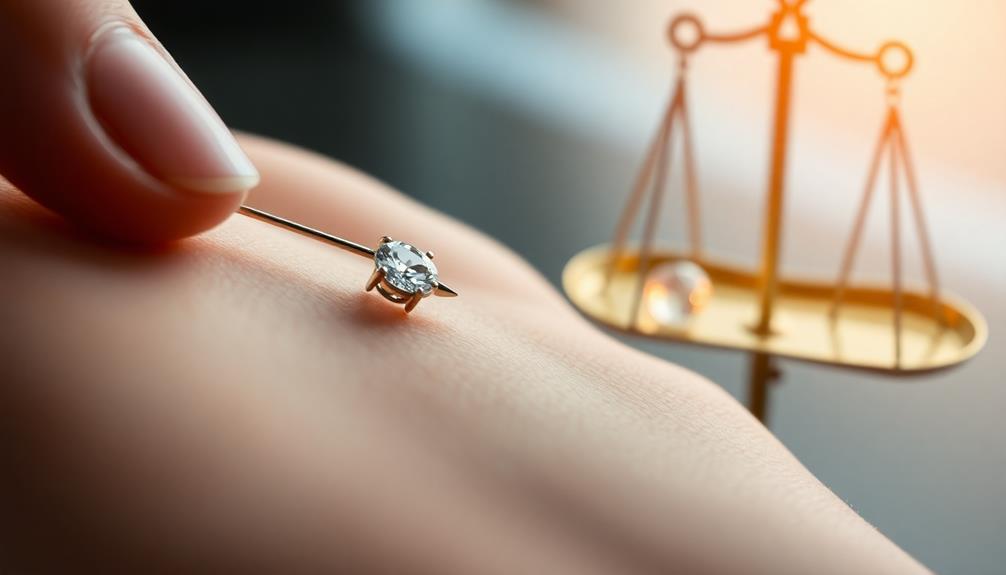
Maneuvering the landscape of surface piercings requires a careful balance of risks and rewards. While they offer a unique aesthetic appeal, the high rejection rates—estimated between 70-80%—demand your attention. Understanding these risks is essential before you commit.
Healing times can stretch from 1-5 years, during which ongoing care and monitoring are critical to minimize complications. Proper piercing care and hygiene are fundamental to guarantee a successful healing process, as neglecting these can lead to infections that compromise your piercing.
Choosing the right jewelry is another fundamental factor in your piercing's success. Opt for surface bars or microdermals to enhance longevity and reduce the likelihood of issues.
Remember, the quality of your aftercare directly impacts your healing process. Poor hygiene can lead to infections or irritation, increasing the chances of rejection.
You should also consider the potential for scarring or noticeable lines if rejection occurs. Weighing these risks against the aesthetic rewards is key.
Embrace the uniqueness of surface piercings, but be prepared for the commitment involved. By staying informed and proactive about your choices, you can navigate this intricate balance and make a decision that aligns with your style and comfort.
Frequently Asked Questions
What Are the Risks of Surface Piercings?
Surface piercings come with several risks, including high rejection rates, migration, and potential infection. If you don't follow proper aftercare, you might experience irritation, redness, or even discharge, leading to complications that require attention.
What Is the Risk of a Surface Tongue Piercing?
A surface tongue piercing carries risks like high rejection rates, infection, and migration. You should monitor it closely, practice proper aftercare, and be aware that complications can lead to discomfort and potential removal.
What Is the Psychology Behind Getting Piercings?
When you get piercings, you're often expressing your identity and reclaiming autonomy. This act can boost your self-esteem, trigger endorphins, and connect you to communities, serving as a powerful coping mechanism during life changes.
Why Not Get a Surface Tragus Piercing?
You might want to reconsider a surface tragus piercing due to its high rejection rate, potential irritation from facial movements, and limited jewelry options during healing. Proper aftercare is essential to avoid complications and disappointment.
Conclusion
In the world of surface piercings, the thrill of self-expression comes with its own set of challenges. You've learned about the risks of migration and rejection, but what if your piercing defies the odds and heals beautifully? Choosing the right jewelry and following proper aftercare could mean the difference between a stunning adornment and a painful reminder. Are you ready to embrace the journey, balancing those risks against the potential for an eye-catching masterpiece? The choice is yours.
Hi, my name is Danielle, and I’m an author for piercings-body.com. I have a passion for writing and love to share my knowledge on all things body piercing-related. I’m also a huge advocate for safe body modification practices and believe everyone should be able to make informed decisions about their bodies. When I’m not writing or blogging, I enjoy spending time with my family and friends, practicing yoga, and exploring new places.

